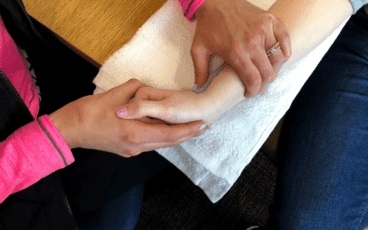
Ergonomic Advice from Our IBJI Physicians
At the start of the pandemic, most people weren’t set up with a proper home office that would have the stamp of approval from an ergonomics specialist. As millions of us were suddenly forced to find a place at home to open our laptops and type away, many of us chose a bed, a chair, a soft couch, or a kitchen table for a setup. While these choices might have been okay temporarily, as time went on, our less-than-ideal arrangements began to take a toll on our body parts.
This blog post describes the pains some work-from-home employees are experiencing, and their causes. Physical Medicine and Rehabilitation Physician Mehul Garala, MD, and Hand and Upper Extremity Orthopedic Surgeon Taizoon Baxamusa, MD share their tips for lowering work-from-home pain and discomfort. They provide advice on how to work from home safely.
Work-from-Home Pain: Low Back Pain
The length of time we have had to work from home, stay indoors, and refrain from our normal exercise routine, commute, outdoor activities, and overall movement has led to the development of work-from-home pain.
“Many patients state that because of inactivity they have had more low back pain than before COVID,” Dr. Garala states. “Inactivity can lead to weak muscles, poor conditioning and stiffness, which can all contribute to the development of pain.”
Proper Work-from-Home Setup
Dr. Garala recommends that your workstation be ergonomically situated to minimize the loads on your low back. “The chair you use is important,” he says. “You want a chair that allows for adjustable angles, including a slight incline, along with good lumbar and arm support. You want to be able to change postures while sitting to change the forces on your discs and muscles.”
Work-from-Home Pain: Neck Pain
Extended cell phone use and laptop use in which a person is constantly looking down can strain the neck muscles. If you use your phone a lot, Dr. Garala recommends using a headset to avoid cradling the phone on your shoulder. He also recommends that you position your laptop on a table or desk so the monitor is at eye level.
Neck & Back Stretches for Work-from-Home Pain
Dr. Garala recommends avoiding prolonged periods of being sedentary. He says, “It’s very easy for patients to be so immersed in their work at home that they haven’t moved in three or four hours. I recommend setting up an alarm reminder on your phone or clock to get you up and stretching every hour. We want muscles to maintain their flexibility and prevent them from shortening which can occur over time with prolonged positions.”
He advises his patients to do simple stretches at home by getting out of your chair as often as possible. The recommended break involves standing and maintaining a relaxed standing position. Perform neck rolls and arm windmills to relieve neck and shoulder discomfort. Raise your hands above your head and reach for the ceiling while taking a deep breath which can help extend your back.
As an added luxury, sometimes a sit-to-stand desk can help promote position changes.
If a patient continues to have discomfort, sometimes OTC medications can be used as an adjunct. As long as there are no medical contraindications, Dr. Garala states that, “using NSAIDs, acetaminophen and/or a topical ointment/patch can provide some additional benefit and pain relief.”
However, if the pain is quite debilitating and leads to functional limitations, Dr. Garala would often suggest a formal physical therapy program where an individualized treatment plan can be implemented.
Insight from an Upper Extremity Professional
Dr. Baxamusa is dual board-certified in orthopedic surgery and hand and upper extremity surgery. He has seen a fair number of work-from-home pain complaints from patients since the pandemic began.
“There have been so many studies on ergonomics and at most jobs, people pay attention to that with computers and stands that are at the proper height. They have the proper work chairs coordinated with that, but none of that translated into the work-from-home scenario,” Dr. Baxamusa says. “People have been making do with it, but as time has gone on, we have started seeing these conditions pop up.”
Work-from-Home Pain: Hand and Upper Extremity Conditions
“If we don’t have the proper support under our arms or if we’re at the improper height at our desks, we can experience shoulder or elbow problems,” Dr. Baxamusa says. “You can get tennis elbow, a common condition that we see from overuse. Oftentimes it’s caused by improper ergonomics.”
Work-from-Home Pain: Tendonitis
Another work-from-home issue is tendonitis. “The flexor tendon can be associated with pain and swelling,” he says. “That crowds the nerves in the carpal tunnel. These things can occur at many levels and issues can co-exist.”
Work-from-Home Pain: Arthritis
“We’re getting patients that are working longer, past middle age, and we start to see arthritis-exacerbated events from improper posture, or not-frequent-enough breaks,” Dr. Baxamusa says. “In young people, we’re seeing improper posture. They’re flexing their elbows excessively, which is causing cubital tunnel syndrome.”
Work-from-Home Pain Solution: Occupational Therapy
“You don’t get pain from the home office, but you do get pain from the dining room table,” Dr. Baxamusa says.
What to do: Make sure your setup is correct with the help of an occupational therapist. “They can help because they are tuned in and specially trained in the hand and ergonomics. We might get a consultation with them so they can pinpoint better and make modifications to eliminate your stressors.”
Takeaway: Occupational therapists can help you recreate your office setup at home, assuming you were working successfully in the office without complaints. Get a proper desk and chair and try to mimic the office environment rather than making do with a laptop on a dining room table. Definitely make a dedicated work environment if working from home for a sustained period of time.
Work-from-Home Pain Diagnosis
You can help your occupational therapist identify what may be causing your pain by simply taking a photo of yourself while working at your desk. You can make modifications to desk height, chair height, and more to alleviate pain.
Schedule online
In Illinois, patients have direct access to physical therapy. This means you don’t need to consult with a physician to get a referral. You can schedule online to undergo physical or occupational therapy and visit five times prior to seeing a physician.
Occupational therapists can employ stretches and exercises to help reduce nerve compression, tendonitis, and more. “If there’s no improvement, it might be beneficial to have a physician assessment,” Dr. Baxamusa says.
See the physical and occupational therapy locations near you.




